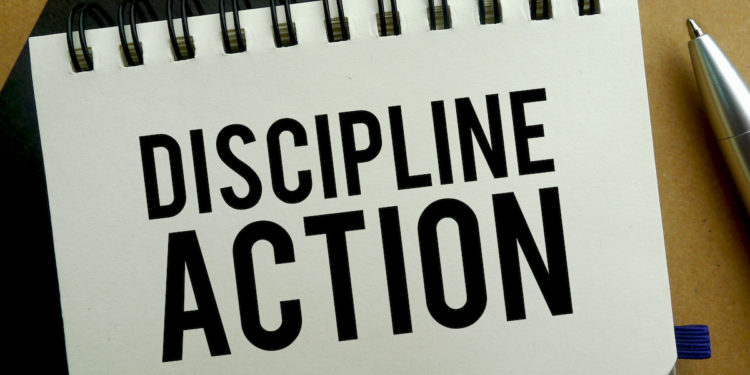Employee discipline can be difficult if you do not have clear guidelines, policies, or procedures. Establishing clear policies and procedures is essential for your small business.
Write an Employee Handbook
Your employee handbook shares your expectations. It is the backbone of your business. Your new employees will have information such as where to park or the dress code. It is also a reference book for your managers or your HR person.
Ensure your handbook is clear and spreads a positive message. You will want to protect your business from litigation, but you also want your employees to go to your handbook for clear and concise answers. They shouldn’t feel threatened.
Progressive Discipline
Progressive discipline is defined as a process for dealing with job-related behavior that does not meet expected performance or conduct. The primary purpose of progressive discipline is to help the employee understand that there is an opportunity for improvement.
If done properly, progressive discipline can help you:
- Address the bad behavior or performance issue immediately
- Open up communication between you and the employee
- Ensure consistency
- Have proper documentation for further employee discipline or termination if the behavior continues
- Show your commitment to the employee
- Lay the framework for those who don’t improve
- Prevent employee turnover
Not addressing bad behavior or performance tells the employee what they are doing is fine. Then, it spreads to other employees. If John always comes in late and his behavior isn’t addressed, then other team members will think it is fine as well.
Ensure you hire great leaders who know when to address an issue. If they aren’t addressing issues, then they aren’t leaders. You don’t want a micromanager, but you do want someone who will solve problems. Great leaders let others know their expectations. They inspire great workers.
Most unemployment agencies or courts would like to know an employer gave progressive discipline for performance or conduct issues. For example, if your employee clocks in late, do you just terminate them? The best way is to offer them progressive discipline. Then, you know you did everything you could do to correct their behavior. Great leaders inspire others to do great work. They also treat employees fairly and equally.
How to Conduct Progressive Employee Discipline
Step 1: Gather Information
When hearing about a situation it is important that you have all sides of a story. You should make sure you conduct a thorough investigation into the behavior. For example, if an employee complains about sexual harassment, it is important that you interview all parties and witnesses. Also, you should listen, ask questions, and write down exactly everything they say. Ask who, what, where, when, and how. Then, ask them to write and sign their statement.
Some issues may be easier like someone clocking in and out late. In this case, you should find out from the employee why they are coming in late. Are they oversleeping? Do they have a childcare issue for the week? Can you arrange different hours to help them come up with a solution to their problem if it is something like childcare? If you do arrange for them to have different hours and they still come in late, then you know you went above and beyond for them. Know when to help your employees out, but also know when you may be taken advantage of as well.
Need an Affordable Time Clock App for Your Employees? Try out ezClocker for FREE!
Step 2: What Type of Employee Discipline is Needed?
Once you complete your investigation, then you should think about what type of discipline is needed. You may want to start with a verbal warning, but some issues are more severe. It is fine to give a harsher punishment if needed, but make sure you are consistent. Also, keep a log of your employee discipline so that as your company grows, you won’t forget.
If you have an employee who has been disciplined for other issues, you should also keep that in mind. If they received a written warning for talking badly to a customer and then have an attitude problem with their manager, you should think about a final written warning or suspension.
Step 3: Prepare Documents
Ensure you prepare documents for each meeting. If you are issuing a verbal warning, you should have a document which they sign that states it is a verbal warning as well.
The warning should include:
- Employee information (first and last name)
- The date of the discipline
- A detailed description of the incident and how it impacts the business
- Prior incidents
- A place for the employee to write their comments
- The corrective action needed
- Print and signature space for employee and manager giving the discipline
For higher level employees, supervisors, or managers, you may want to consider giving them a performance improvement plan (PIP). This is a document that has more written information with more details on the behavior and corrective actions needed. For example, if you have a manager who is micromanaging their employees and getting many complaints, you may want to consider a PIP. These give more details of how they should correct their behavior and what training or other ways they can learn to be a better manager. Sometimes employees need guidance. It is your job to get them there.
Step 4. Meet With Your Employee
When you have prepared all documents, you should meet with the employee. State clearly what the problem is and how you want to help them improve. Giving employee discipline does not have to be a negative experience. Explain to them how their behavior or performance is hurting the business. Tell them what the consequences are if their behavior continues.
Zero Tolerance
Some matters are considered instant termination and your company may have zero tolerance for those issues. Zero tolerance language should be written in those policies. For example, bringing a gun to work, threatening other employees, or sexual harassment. These violations can clearly state that you do not allow them. If you write that in your policies, they should be followed.
If you have zero tolerance for some workplace behaviors, you should:
- Make sure you are consistent
- Ensure you state your zero tolerance expectations in your policies
You should make sure that if you say zero tolerance on a policy, you can uphold that policy. You should always think about whether your decisions would uphold in court. Also, sometimes people make you mad. Make sure you aren’t making your decisions because you personally don’t like someone. Get advice from other managers or your HR person. You need unbiased opinions from others sometimes to make good decisions.
Final Thoughts on Employee Discipline
Know your state and federal laws when writing policies for employee discipline. If you have offices in different states, your laws may be different. For example, in one state you may be able to drug test. In another state, you may not. You should also consider having an employment law attorney review your policies and handbook.
Don’t make a policy if you will not enforce it.
Think about how you are going to address your concerns. Also, do not meet with the employee if you are angry. Be kind when addressing your concerns. Resolve your employee issues carefully and thoughtfully.
Do you have any advice on employee discipline? please share in the comments section.





6 comments